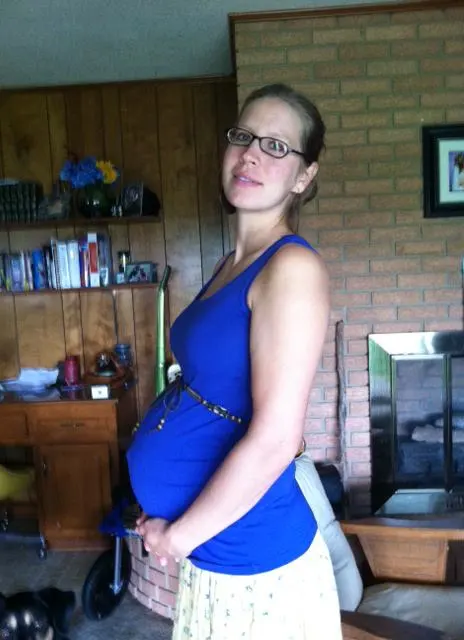Dedicated followers of Dr. Pol’s reality TV show recognize Dr. Emily as one of the program’s most remarkable personalities. Her unwavering presence in every episode left a lasting impression on fans, who were often astonished by the confidence with which this female veterinarian handled even the most aggressive animals. However, her departure from the show in 2019, during its 15th season, marked a significant transition.
Dr. Emily made her debut at Pol Veterinary Services in 2015, and among the show’s impressive cast of characters, she managed to stand out for several compelling reasons, notably her extensive knowledge and unwavering dedication to her profession. Even during the late stages of her pregnancy, she fearlessly continued to treat unruly bulls, cantankerous goats, and ailing cows. There was a memorable moment when, with maggots crawling over her hands, the 34-year-old doctor tended to an injured dog. Her dedication didn’t go unnoticed, and even the animal’s owners were taken aback by her commitment.
In remarkably little time, Dr. Emily had endeared herself to the show’s fans and become a firm favorite among them, celebrated for her exceptional skills and unshakable devotion to the well-being of the animals she cared for.
Why Did Dr. Emily Leave Dr. Pol?

Caption: Reality Tv star, Dr. Emily Thomas net worth
Dr. Pol’s veterinary facility was renowned and constantly bustling, catering to a vast clientele daily. The workload, however, had grown disproportionately to the available staff. For Dr. Emily, who was not only a dedicated wife but also a mother to three children, the demands became overwhelming. It was a situation that pushed her to a breaking point, ultimately leading her to make a profound choice in favor of her family, even at the expense of a lucrative income and the allure of continued TV appearances.
Dr. Emily had undeniably accumulated a wealth of experience during her time at the clinic, making her well-prepared for the next phase of her career. Her contributions were substantial, appearing in a remarkable 95 episodes of “The Incredible Dr. Pol” from 2015 to 2019, and an additional five episodes in “Calling Dr. Pol” from 2015 to 2016. This impressive track record served as a testament to her expertise and dedication in the field of veterinary medicine.
Dr. Emily Recently Got Hysterectomy
Dr. Emily, a renowned veterinarian known for her courage in handling aggressive animals, faced a life-altering decision. Despite her remarkable career and dedication, a persistent health issue had pushed her to the brink. Unrelenting pelvic pain and debilitating menstrual bleeding had cast a shadow over her busy life as a veterinarian, wife, and mother of three.
After consulting her trusted friend and colleague, Dr. Anderson, she received a diagnosis: a large uterine fibroid was the culprit behind her suffering. Dr. Emily knew she had a difficult choice to make. Just as she had always prioritized the well-being of her animal patients, she now had to prioritize her own health.

In a courageous decision, Dr. Emily opted for a hysterectomy, choosing to put her health and family first. The surgery marked a turning point in her life, allowing her to continue her career, be there for her family, and enjoy a life free from the pain that had plagued her for so long.
Dr. Emily’s story served as an inspiring reminder that, sometimes, even those who dedicate their lives to caring for others must prioritize self-care and well-being.
Many Fans showed their support, here are some fans comment on her instagram post
Take care of yourself! Be sure to relax and recover for a few weeks. I know it seems like a long time, but definitely need the time to recover. After my full hysterectomy I tried to do life after two weeks (simple thing like working an office job) and ended up delaying my recovery even longer. Week 7 is about when your nerves will start regenerating too and that’s a new wave of recovery. Take care and let your family taken care of things ????
another fan wrote,
You will love it! Best thing ever. If I still had one, I’d remove it, put it in formalin & superglue it to the Supreme Court steps!
https://x.com/DrEmilyThomas/status/1696461735866110372
Hysterectomy: A Comprehensive Overview
A hysterectomy is a surgical procedure that involves the removal of a woman’s uterus, the organ where a fertilized egg implants and a pregnancy develops. It is one of the most common surgical procedures performed on women, and it can be done for various medical reasons. This article will provide an overview of hysterectomy, including the procedure, associated risks and difficulties, and the potential results.
Procedure: A hysterectomy can be performed through different surgical methods, each with its own approach and advantages:
- Abdominal Hysterectomy: In this method, an incision is made in the abdominal wall, typically either horizontally (across the lower abdomen) or vertically (from the navel down to the pubic bone). The uterus is then removed through this incision. This approach may be necessary for large uterine fibroids, cancer, or when the surgeon needs a better view of the pelvic organs.
- Vaginal Hysterectomy: In a vaginal hysterectomy, the uterus is removed through the vaginal canal. This method leaves no visible abdominal scars and typically has a shorter recovery time than abdominal hysterectomy. However, not all conditions can be treated using this approach.
- Laparoscopic Hysterectomy: Also known as minimally invasive surgery, this method involves making small incisions in the abdomen and using a laparoscope (a thin, flexible tube with a camera) and surgical instruments to remove the uterus. Laparoscopic hysterectomy may result in less pain, shorter hospital stays, and quicker recovery times compared to abdominal hysterectomy.
Risks and Difficulties: While hysterectomy is a generally safe procedure, it does carry certain risks and potential difficulties, including:
- Infection: As with any surgery, there is a risk of infection at the surgical site or within the abdominal cavity.
- Bleeding: Excessive bleeding during or after the procedure can occur, potentially requiring blood transfusions or additional surgery.
- Injury to Nearby Organs: The surgery involves delicate tissues and organs near the uterus, such as the bladder and intestines. Damage to these structures can occur, although it is relatively rare.
- Recovery Period: Depending on the type of hysterectomy and individual factors, recovery can take several weeks to several months. Some women may experience pain, discomfort, or emotional adjustments during this time.
- Hormonal Changes: Removal of the uterus often leads to hormonal changes, as it can affect hormone production and the menstrual cycle. If the ovaries are also removed, this may result in immediate menopause.
Results: The outcomes of a hysterectomy vary depending on the reason for the surgery and the specific circumstances of each patient. Here are some potential results:
- Relief from Medical Conditions: Hysterectomy can provide relief from conditions such as uterine fibroids, endometriosis, heavy menstrual bleeding, and certain types of cancer. It can alleviate symptoms and improve a person’s overall quality of life.
- Infertility: Hysterectomy is a definitive solution for fertility issues, as it renders a person unable to carry a pregnancy. This is an important consideration for women who wish to preserve their ability to have children.
- Emotional Impact: Hysterectomy can have emotional and psychological effects. Some women experience a sense of loss or grief, while others feel relief from chronic pain or the fear of certain medical conditions.
- Lifestyle Changes: Post-hysterectomy, women may experience changes in their sexual function, hormonal balance, and body image. These changes can be managed with appropriate medical care and support.
In conclusion, a hysterectomy is a surgical procedure with various approaches and outcomes. It is essential for individuals considering this surgery to discuss their options thoroughly with their healthcare provider, taking into account their medical condition, desired outcomes, and potential risks and difficulties. The decision to undergo a hysterectomy should be well-informed and made in consultation with a trusted healthcare professional.





